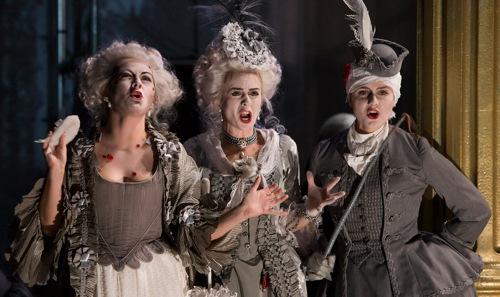
Wexford is a small town on the sea in the south-east of Ireland and an unlikely place to host an opera festival. Yet since 1951 in late October the town has organized what has become for many opera-lovers an essential date in the calendar. The reason why it has remained important is not merely the intimacy of the setting, the general air of welcome and the strange sea-washed beauty of the old town, but the policy since the early 1970s to program three operas that have fallen beneath the radar, that are seldom or never performed.
Thus if you wanted to see Cornelius’s Der Barbier von Bagdad, you had to come to Wexford in 1974; so too with Tiefland by d’Albert (1978) or Edgar by Puccini (1980) or Le Jongleur de Notre-Dame by Massenet (1984). The opera house, down a side street, was old and uncomfortable, but that seemed only to add to the general specialness of the occasion. Last year however, a brand new opera house, built on the same site, was opened. The seats are more comfortable, the acoustics are wonderful, and the building itself has managed to lose nothing of the old intimacy.
Usually, there is much debate about the quality of the operas. Since many people from the town work as volunteers and extras who are involved in rehearsals, rumors spread each year that one of the three productions is way ahead of all the others, a lost jewel perhaps, or a production with a great young singer. This year, while there was much talk about some of the beautiful moments in Donizetti’s Maria Padilla, the view in the town was that there was something very special coming on the opening night, that an opera was about to performed which would be remembered for many years. This proved to be true. It was The Ghosts of Versailles by the contemporary American composer John Corigliano, which was first performed at the Met in New York in 1991, put on in Wexford in a new scaled-down version suitable for a smaller stage.
The plot, which centers on the relationship between Beaumarchais and Marie Antoinette, is ingenious and intricate and would have pleased John Barth and Pirandello. The libretto by William Hoffman is brilliant and clever, but does not show off to the detriment of the music; there is a beautiful way in which it allows scenes their full dramatic import, without cutting across them with too much knowing interjection. While the libretto is full of knowingness, there is a lightness about how this is presented. The opera allows the audience, aware of the games between played on the stage between fantasy and reality, between real figures from history and figures from opera, to do the knowing rather than being distracted by being told that it is coming soon.
The music includes references to earlier music from grand opera to opera buffa, but these references are haunting or funny rather than mere pieces of pastiche. Some of the music is unashamedly beautiful, but there is also a thrilling contemporary edge to some of the singing and orchestration, and there was something wonderful, even novel, about the arrival of moments of percussive, exquisite atonality in a small Irish town. (I went to high school in Wexford and don’t remember atonality being a regular part of the fare.)
It was clear to the audience on the opening night in Wexford that this opera belongs in a central position in any repertoire. The self-consciousness in the scoring works wonders against a sort of musical innocence in the piece, and then that very innocence is constantly wrong-footed and usurped. This made us all sit there amused and amazed that a work from the past twenty years could have a sense of classic completion while never allowing us relax or get lazy as we listened. It was the great revelation at the Wexford Opera Festival this year.


